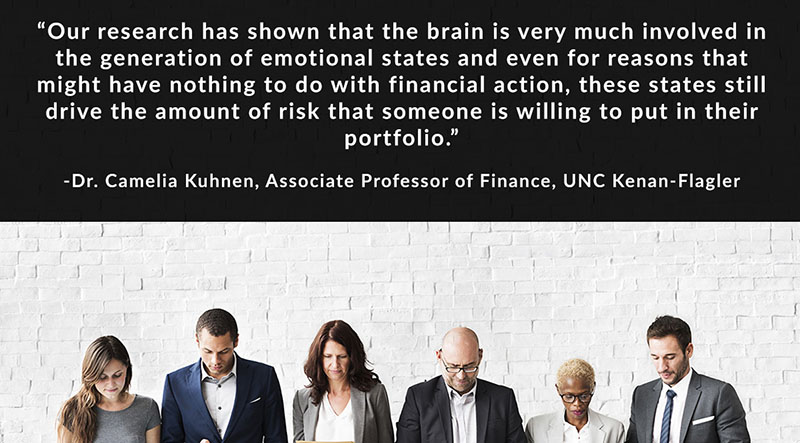
Let’s talk about overcoming objections – and the way a developing scientific field called neurofinance can help.
In the battle between logic and emotion, are you Spock or are you Kirk? Which one would you want helping you sell life insurance? For a long time, the answer probably would have been Spock. But there are a few good reasons why Kirk might be a better choice.
I think the biggest discovery to come out of neuroeconomics is…unconscious emotion. You can be in the grip of very powerful feelings and have no concept that you are actually feeling them.
The field of neurofinance combines psychology, neuroscience, and economics. The goal is to understand how and why people make decisions about their financial future. The old economic models assume human beings make financial decisions rationally – but this isn’t the case.
The human brain has about 86 billion neurons and we understand very little about how they connect with each other. What we do know is that these neurons provide each of us with two modes of decision-making - let's call them cautious mode and unconscious mode.
- Cautious mode: This mode of decision-making is one you’re familiar with. That’s what causes prospects to present their objections. It’s that little voice in the back of their head saying, “Wait. This might not be a good idea. Just hold off until you figure it out.” The brain activates this mode of decision-making when there are multiple solutions to a problem. This is also the mode of decision-making that leads many stock market investors to trade too frequently, usually resulting in a loss.
- Unconscious mode: This mode of decision-making happens before you even realize it. It’s what prompts you to move your hand away from a hot burner, or to swing a golf club the same way you’ve practiced it thousands of times before. It’s instinctive, learned behavior that happens with little or no conscious thought. The brain activates this mode of decision-making when there is one clear solution to a problem.
Logic versus Emotion
So which part of the brain gets activated when a prospect thinks about retirement planning?
That depends.
In 2005, researchers from UNC and Stanford published a paper on parts of the brain and how they relate to financial decision-making. The study subjects had to make an investment choice between two stocks and a bond.
Researchers used fMRI imagery to see which parts of the brain lit up as they made their choices:
- Turns out, the nucleus accumbens activated before subjects made risky choices – choices that could either pay off big-time or hurt them financially. The lure of the big pay-off was too strong to resist, in some cases.
- The anterior insula activated before subjects made choices expected to prevent risk and loss – safe choices that wouldn’t result in a gain, but wouldn’t expose them to risk, either. In this case, the fear of financial catastrophe made the subjects' choices for them.

What does this tell us?
These findings suggest that distinct neural circuits linked to anticipatory affect promote different types of financial choices, and indicate that excessive activation of these circuits may lead to investing mistakes.
These parts of the brain also process non-financial decisions. The parts that process possible financial gains are also stimulated by other rewards like food, music, or even drugs. The parts that process possible financial losses also process negative emotions like fear, pain, and disgust.
In other words, our brains can’t separate emotional issues from financial ones. Even if we’re supposed to be logical when thinking about finance, our brains don’t always allow for that. Instead, they evaluate the emotions a particular decision will cause us to feel:
- Can I gain wealth or material goods that will bring me happiness?
- Can I achieve something that will bring me satisfaction?
- Will I experience pain or loss if I make the wrong choice?
As the study showed, if the brain’s sense of pain, fear, or loss overrides logic, a prospect will make a safe choice to avoid that fear. If the brain’s sense of jealousy or desire for the happiness that others have achieved wins out, a prospect will be more willing to take a risk.
Tap into Emotion to Set the Stage
Okay, so we know the brain will subvert pure logic when it comes to making financial decisions. Fear, regret, and disappointment all play a role in our decisions. In other words, FOMO isn’t just for social media.
Emotions rule our brains.
So why do we focus on the logic of buying a particular product?
To sell retirement planning solutions like IUL, for example, we usually use logical arguments like these:
- The advantage of cash value growth tied to an index
- The average growth percentage per year compared to other investment options
- The built-in downside protection
- The value of the death benefit
But as we’ve seen, if there’s an overriding fear in a prospect’s brain, that fear will trump logic and they won’t buy, no matter how many logical safeguards the policy has.
As counter-intuitive as it is, think about emotion when you’re trying to make a sale:
- How will this decision make a prospect feel?
- What kinds of risks or rewards might they face in return?
- What negative emotions do they eliminate by taking this step?
But how do you bring that emotion out in your clients and prospects?
Ask Questions
If you’ve read any of our posts that feature excerpts of Van Mueller’s newsletter, you’re already familiar with this advice. For example, in his January newsletter, he wrote:
Planning is vital because no one knows what is going to happen. Ask prospects and clients if they realize that they can succeed even if no one knows what will happen. They can have the financial success they desire. All they have to do is create a plan for success. I don’t know many people who could resist that.
He goes on to suggest that when talking about a client’s finances, you make it personal. “Ask them how these events will impact their savings, investments, jobs, retirements and their futures. What if because you know about these issues you could plan for them rather than be hurt by them, wouldn’t you have a better outcome than you had in the past?”
The point of this strategy is to get your prospect talking.
If you steer the conversation by asking questions, your prospect feels in control – and that’s something that doesn’t happen often in the world of money and finance. If they feel like you're listening and engaged, that will give them the confidence to engage with you.
Asking questions is the key. It gets your prospects tuned into their emotions, including their fears. Once they’re tapped in and willing to share, you can show them how your proposed solution eliminates fear and encourages peace of mind.

Change Your Vocabulary to Close the Sale
Let’s say you’re talking about retirement planning, this month’s focus topic.
If you present a solution like IUL, there’s a good chance you’ll get a blank stare in return. If you ask what your client thinks about it, the truthful answer is probably, “I don’t get it” or “I don’t know what to think.”
You can avoid both of those answers by changing the question you ask.
Don’t ask what they think.
Ask how they feel.
Everyone can answer a question about how they feel, even if that feeling is confusion. It’s less intimidating to say “I feel confused about IUL” than it is to say “I don’t know what this means” or “I have no idea what I'm doing.”
By giving your prospect an easy way to ask for more information, you’re letting the conversation flow in a non-threatening way. You can explain what the product does, the problems it can solve, and how those solutions can bring positive feelings and changes in your prospect’s life.
Once you have them on board, close the sale by reinforcing that positive emotion with social proof.
Reinforce Their Decision
If thinking could make everyone a great investor, then there wouldn’t be market bubbles and panics, poverty, addiction, or criminal greed.
Social proof helps your prospect feel good about the decision they’re making. It means they’re not alone – and this is a confidence-builder.
In a sales context, you can provide social proof by adding information about how your other clients felt in this situation. You can do this without giving identifying details. Just convey the fact that other clients came to you with similar feelings, and you saw firsthand the relief and satisfaction they felt when you solved their problems together.
For example, you could say, “I met with a client just last week who made this same decision. They were really jittery about a possible stock market crash in the near future. They felt a big sense of relief once they realized they wouldn’t lose money in their IUL if this were to happen.” This amplifies the positive emotion by eliminating fear and jealousy – no FOMO here.
Take a look at your sales scripts. How often do you ask questions?
When you ask them, do you ask how your client feels or what they think? Do you give them places to stop and ask questions? If you’re not sure what to ask, refer back to the post where Van Mueller provided a huge list of questions to choose from.
That's our quick look at neurofinance!
This is a developing field, so there's lots more to discover about how our clients and prospects make financial decisions. Have you used emotion rather than logic to explain advanced planning concepts to clients? How did it go? Do you have other tactics that work? Tell us in the comments!
